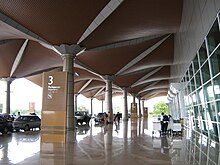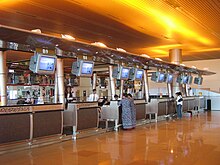Kuching Airport
| Kuching International Airport (KIA) Lapangan Terbang Antarabangsa Kuching |
|
|---|---|

|
|
| Characteristics | |
| ICAO code | WBGG |
| IATA code | KCH |
| Coordinates | |
| Height above MSL | 27 m (89 ft ) |
| Transport links | |
| Distance from the city center | 11 km south of Kuching |
| Basic data | |
| opening | 1962 |
| operator | Malaysia Airports SDN BHD |
| Terminals | 1 |
| Passengers | 3,195,352 (2006) |
| Air freight | 32,830 t (2006) |
| Flight movements |
41,380 (2006) |
| Capacity ( PAX per year) |
5 million |
| Start-and runway | |
| 07/25 | 2454 m × 60 m asphalt |
Kuching International Airport is the civil and military airport in the city of Kuching in the Malaysian state of Sarawak on Borneo .
In 1962 a British military division built an airfield at what is now the airport. The Royal Air Force Station Kuching , or RAF Kuching for short , served transport aircraft and temporarily housed detachments of the interceptors stationed in RAF Tengah .
Today the airport is numerically the second largest airport in Malaysia; behind the Kuala Lumpur International Airport of the capital Kuala Lumpur . Among other things, the airport has a single runway and a modern passenger terminal.
On March 1, 2006 , the major parts of a general overhaul and expansion of the airport were completed, including the construction of a new terminal building and the expansion of the taxiway and runway system. The slope extension to 3750 m should be completed in 2007.
In addition to a dense regional route network, KIA also has international routes to Singapore and China . The most important local airline is the Malaysian low-cost airline AirAsia .
Airport grounds
The airport area extends over an area of around 190 hectares along the only 2.5 km long runway in an east-west direction.
A parallel taxiway runs north of the runway over a length of 1800 m . This run is connected to the runway with three approach and departure paths. Both the runway and the taxiway are currently being extended to 3750 m in length and, once the construction work has been completed, the Airbus A380 , the largest passenger aircraft in the world, can be used.
Today's passenger handling building is at the same location as the former passenger building, north of the runway. In front of it is a 55,000 square meter apron . It offers space for around 15 aircraft of various sizes. The air traffic control facilities and the control tower are located to the east of the passenger building.
Maintenance hangars are located both west of the passenger building and south of the runway. The majority of the facilities south of the runway are used by the Malaysian Air Force , which operates an air force base in Kuching .
Passenger terminal building
The new, modern passenger terminal was officially inaugurated on April 17, 2006 by the Malaysian Prime Minister Datuk Seri Abdullah Ahmad Badawi .
The three-storey passenger building is divided into an international and a national area and consists of a main terminal building and a directly connected, upstream pier building. The pier building can be further divided into a one-story and a two-story wing.
The baggage claim , customs control and arrival hall and access road are located on the lowest level . The floor above represents the main level of the pier building. The gates with the waiting lounges for passengers are located here. The airlines' offices are located in the main terminal building on this level. The third floor houses the departing passenger facilities, including two groups with check-in desks and the immigration desks .
Similar to the main terminal building in Kuala Lumpur, the passenger building in Kuching can be easily expanded by adding additional building units.
Nine boarding gates are equipped with passenger boarding bridges , three of which have two passenger bridges and Gate 9 is even designed to handle the world's largest passenger aircraft, the Airbus A380. This makes Kuching the second airport in Malaysia after the capital's Kuala Lumpur International Airport that is designed for aircraft of this size.
Four parking positions are also intended for fan guns. At the moment, however, this is only used by the low-cost airline AirAsia to save costs. The airport charges for aircraft operated by this airline are lower because there are no passenger boarding bridges and the gates are the furthest away from the main terminal. The regional aircraft are currently being handled in parking positions for standard fuselage aircraft.
The building structure and architecture is strongly based on Kuala Lumpurs Airport . For example, the roof structure over the approach road is almost identical to that at the capital's airport. In contrast to the old terminal building, local design elements of the Orang Asli peoples (indigenous people) can only be found in the cladding of the check-in counters, while the previous building was strongly based on the architecture of the Orang Asli.
Airlines
Kuching is the second busiest airport in Malaysia, which is why it is served by numerous Malaysian airlines as well as some foreign airlines.
The Sarawak government is continuously seeking new connections. The main search is for new flights abroad after the state carrier Malaysia Airlines started long-haul flights and the like. a. to Frankfurt , Sydney and Perth . With the Singaporean Tiger Airways and AirAsia's announcement of routes to Bangkok , Jakarta and Macau , these efforts are bearing their first fruits.
AirAsia's subsidiary AirAsiaeXpress will possibly offer long-haul flights ( Guangzhou , Taipei ) ex Kuching from the end of 2007 .
Accidents / Incidents
Over the past decade, the airport has made the headlines for several incidents.
- 1999: A De Havilland Canada DHC-4 Caribou of the Malaysian military crashed in a swamp near the airport. Five inmates were killed.
- 2006: In February, an Airbus A330 operated by Malaysia Airlines came to a halt just a few meters from the end of the runway after the pilot canceled take-off due to engine problems.
Just a few days later, a DHL freight machine slipped over the end of the runway after a failed landing.
In mid-2006, flight operations suffered from two bomb threats which turned out to be a joke.
In September, another Airbus broke off take-off and skidded in the end area of the runway. - 2007: In January, when a Boeing 737 crash- landed, the occupants got away with the horror.
- 2011: On January 10, an AirAsia Airbus A320 (flight 5218) landed on the right of the runway and landed on the grassy surface, causing the nose landing gear to collapse. Heavy tropical rains fell over the airport during the landing. Four inmates were slightly injured during the evacuation.
Web links
Individual evidence
- ↑ dca-sarawak.gov.my ( Memento of the original dated December 23, 2010 in the Internet Archive ) Info: The archive link was inserted automatically and has not yet been checked. Please check the original and archive link according to the instructions and then remove this notice.
- ↑ Website of the airport operator
- ↑ a b c ACI ( Memento of the original from February 22, 2016 in the Internet Archive ) Info: The archive link was automatically inserted and not yet checked. Please check the original and archive link according to the instructions and then remove this notice.
- ↑ The Borneo Post - English-language daily newspaper for Borneo ( Memento of the original from December 15, 2007 in the Internet Archive ) Info: The archive link was inserted automatically and has not yet been checked. Please check the original and archive link according to the instructions and then remove this notice.





